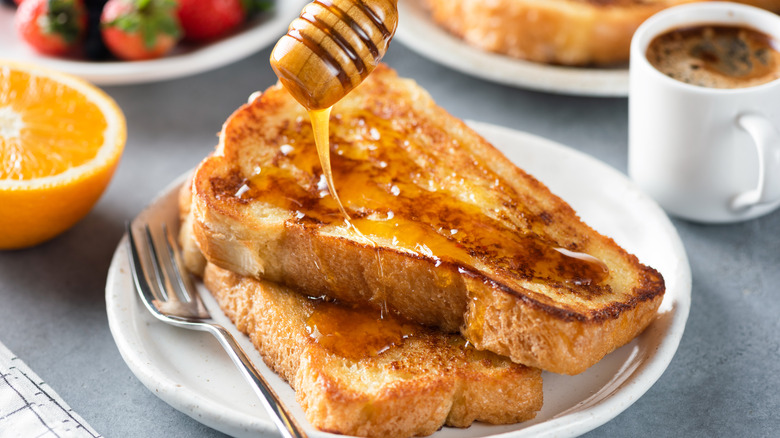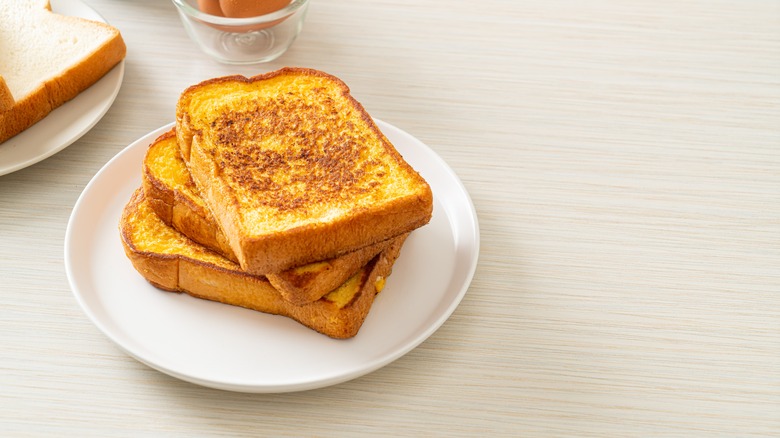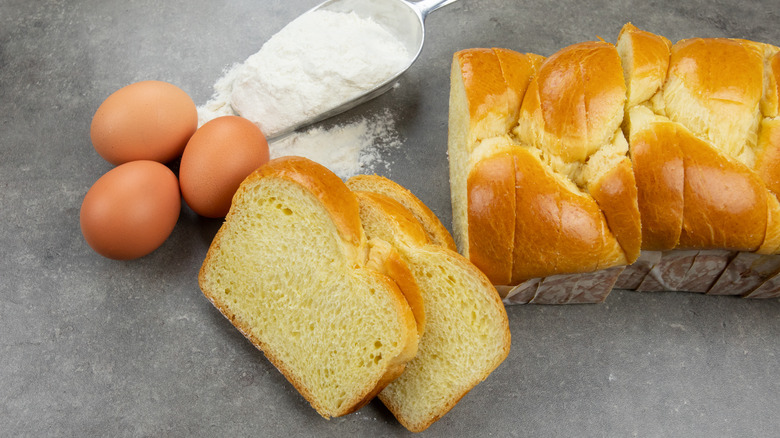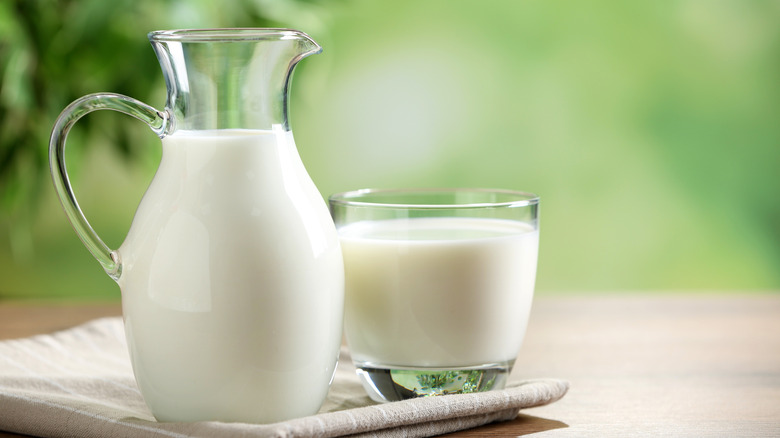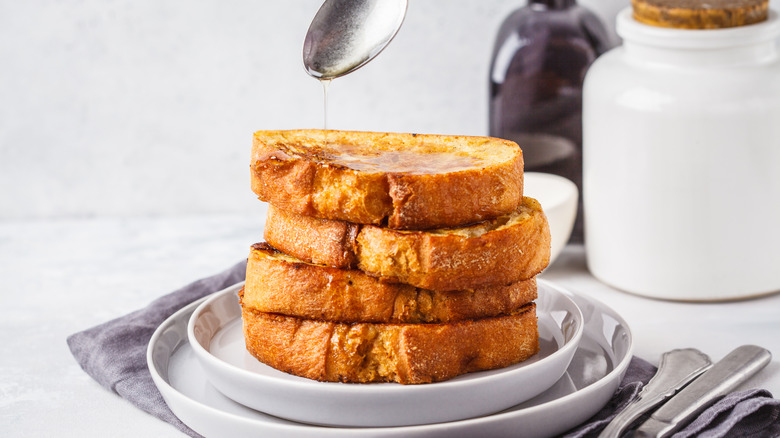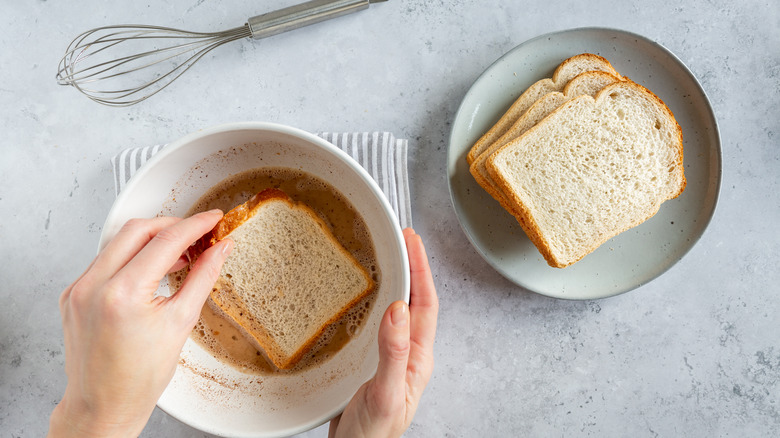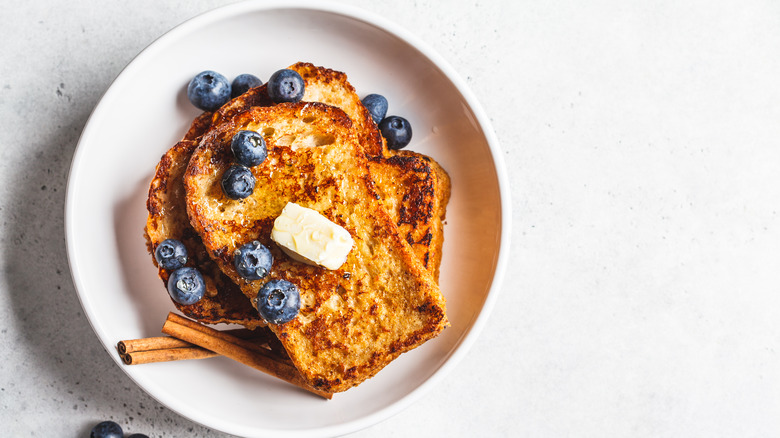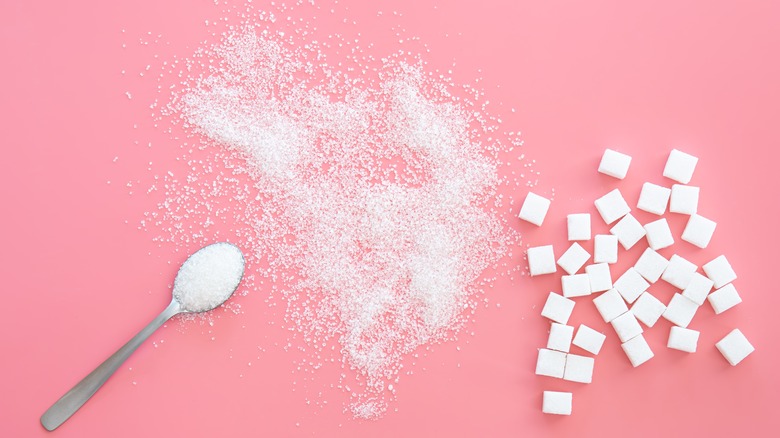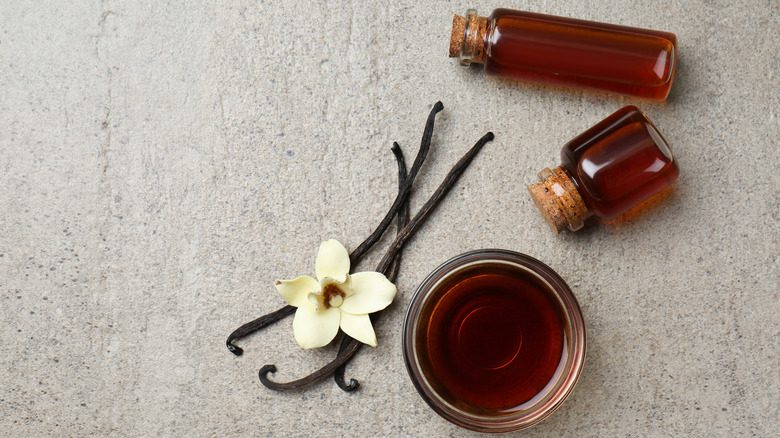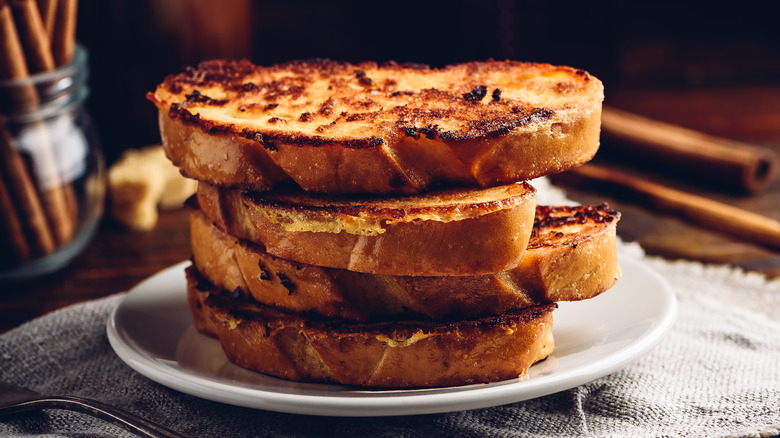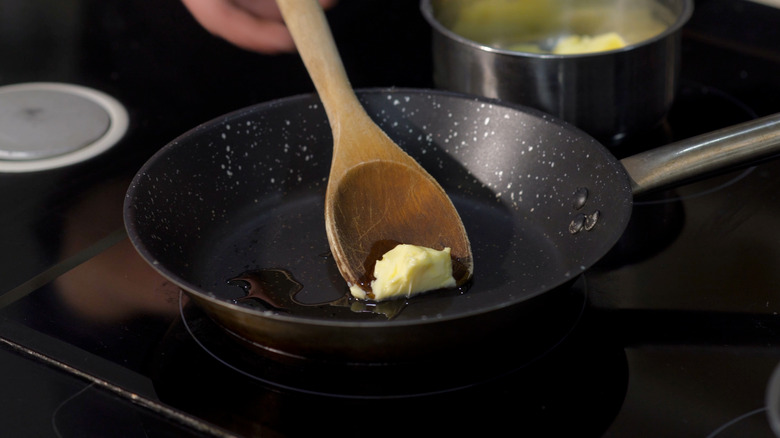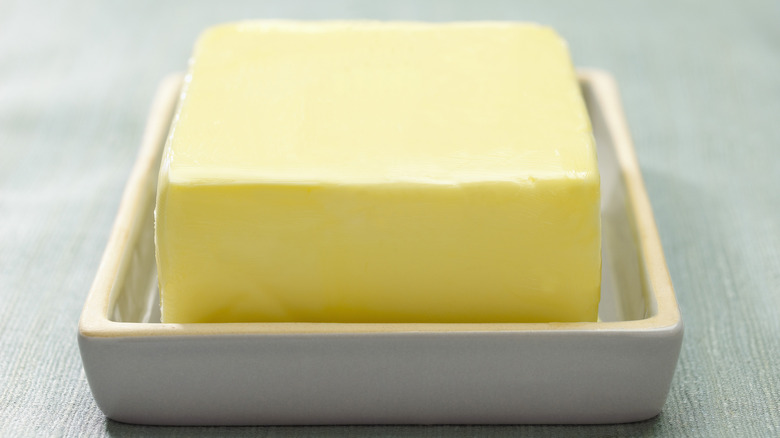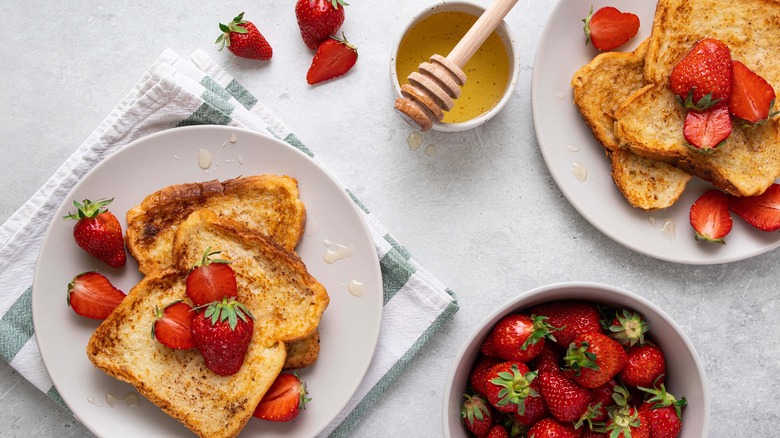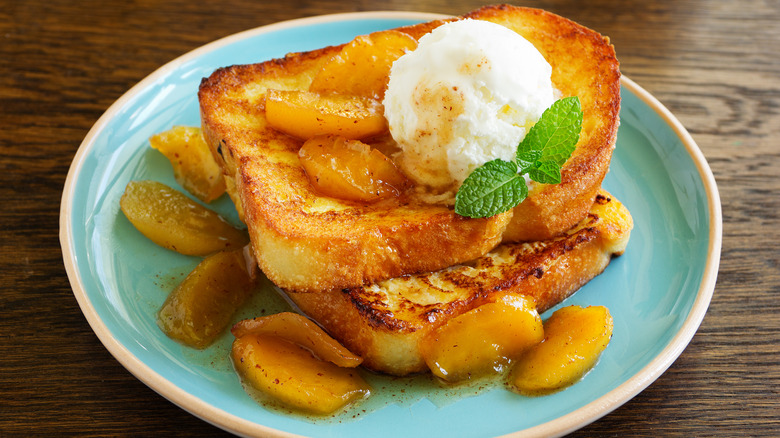14 Tips For Making Your French Toast Taste So Much Better
It's not hard to get stuck in a rut at breakfast time. Figuring out what to make first thing in the morning, when your brain isn't warmed up yet, can be hard. It's easy to fall back on simple things like toast or cereal. But we all deserve a treat now and again — and there are few treats better than French toast.
Folks have been making, enjoying, and perfecting this meal for thousands of years. French people originally called the dish "Roman bread." But the name "French toast" was coined by Americans, who named the dish after a recipe that French communities living in the United States would often make.
French toast is one of those things that's hard to get wrong. You can easily get comfortable with making it. But to make a mind-blowing French toast dish, you need to master a few tips and tricks. From the true length of time that you should soak your bread, to secret ingredients in your batter, we've got all of the little-known techniques you'll need to make the best French toast of your life. Here are 14 tips for making your French toast taste so much better.
1. Always start with stale bread
The success of your French toast depends enormously on the bread that you're using. Beyond what type of bread you choose, you need to make sure that it's a little bit stale.
Slightly stale bread is the ideal choice for French toast. A dry slice of bread will be more eager to absorb the custard it will be dipped in. This means that it'll be better at soaking up this delicious batter. Stale bread is also harder, making it more likely to keep its shape better than softer bread, which is at risk of getting too soggy and falling apart.
The best way to make bread stale is simply by leaving it be. If you know you're going to make French toast on a certain day, take your bread from its packaging the day before, and leave it out. This will allow it to firm up and dry out properly. If you forget to do this, you can also throw your bread slices in a low oven for 10 to 15 minutes, to speed up the drying process. You could even pop them in the toaster for a short amount of time.
2. Certain loaves will yield the best results
Although French toast can be made with many different types of bread, not all of them will work best. Make sure you're selecting your loaf carefully. The best bread for making French toast is arguably one of the easiest to find: the good old-fashioned sandwich loaf.
White or brown loaves will both make a great French toast. However, we recommend purchasing a whole loaf, and not a sliced option. This way, you'll be able to slice it to your desired thickness. Try not to choose a loaf that's too crusty or dense, as this can just make the finished product hard to eat.
If you're after something a little richer, picking a sweeter bread like brioche can raise your toast game. But remember that brioche and other cake-like breads have a tendency to be a bit weaker. This means they may be more likely to fall apart in your custard. If you're using brioche, try to find a dense variety and let it become as stale as possible first, so that it's better prepared to soak up all of those delicious juices.
3. Add a good amount of dairy
In England, French toast is sometimes referred to as "eggy bread." This name should give you a good idea of what this toast's batter is made of. But dipping your toast in eggs alone is a recipe for disaster, folks.
If you neglect to add dairy — in the form of milk, cream, or half-and-half — your French toast will miss out on vital sugars, fats, and proteins, all of which come together to allow the dish to cook and brown properly.
Naturally, the richer the dairy you're adding, the richer your French toast will end up being. Half-and-half is a good choice that provides fat and texture without becoming too claggy, as Alton Brown demonstrates via YouTube. It's best to avoid skim milk if possible, as this won't provide a huge amount of flavor. Whatever choice of dairy you use, ensure that you're not adding too much. If your egg-to-milk ratio is off, your custard will be too runny, and your bread will absorb too much, as opposed to gaining the thick, luscious coating that you're aiming for. The result of this will be a wet plate of food, and some pretty unhappy brunch guests.
4. Add a secret ingredient to vegan French toast
French toast is one of those dishes that rely heavily on the use of animal products for maximum taste. But why shouldn't vegans get in on the fun, too? With a few substitutions, you can make a supremely delicious vegan French toast that's accessible for virtually any diet. To make dairy-free and egg-free French toast, use coconut milk.
All you have to do is pour a can of full-fat coconut milk into a bowl, add any additional flavorings that you desire, and dunk your bread right in. Coconut milk provides a luxurious coating that rivals most egg-based custards.
Using coconut milk is also a great way to get around using eggs that are too expensive for your weekly shopping budget. To make things a little more robust, you can also whisk some cornstarch into the coconut milk. This ingredient helps your toast to firm up and fry better in your pan. Just make sure that you're sieving the cornstarch into the mixture so that it doesn't clump up.
5. To avoid wet toast, soak it for a specific length of time
Nothing ruins French toast like sogginess. While the dish needs to have a certain level of moisture to deliver that juicy, succulent taste that everyone knows and loves, wet French toast can leave you with a meal that feels more like soup. The secret to perfect French toast consistency, however, lies in the amount of time that you soak it for.
Unfortunately, the length of time you need isn't an exact science. It depends on how thick and stale your bread is before it's dipped in the custard.
In some situations, you may only need to soak your bread for around 20 seconds on each side — especially if it's less dense and absorbs the custard quickly. If your egg mixture or your bread is thicker, you'll need to soak it for longer — sometimes up to 10 minutes on each side. The main thing to do is to keep an eye on it and remember that less is usually more when it comes to soaking things. Also, allow any excess custard to drip away from your toast before putting it in the pan to fry it. This way, you don't end up inadvertently boiling your bread in its own juices.
6. To amp up the flavor, stuff your French toast
French toast is good and all. But it doesn't get any better than stuffed French toast. Stuffed French toast is the ultimate crowd-pleaser. Your friends and family are sure to enjoy the delicious surprise of whatever fillings you've put inside your slices of bread. One of the best things about stuffed French toast is that you can put virtually anything inside it. This includes fillings like fresh sliced berries, Nutella, cream cheese, peanut butter, and jelly. The world is your oyster.
But how do you stuff toast, you ask? It's as easy as making a sandwich. For an easy stuffed French toast recipe, just chop up some berries and bananas and place them on a slice of bread. Put a nut butter of your choice on a second slice, and sandwich the two pieces of bread together. The nut butter will work to adhere the pieces of bread to each other, with the berries contained inside. Then, either slice your French toast into triangles or keep it as a whole piece, before soaking it in your batter. Finally, fry it in a pan or on a griddle. The look of joy when your loved ones cut into that piece of toast and find the delicious treats inside is hard to beat.
7. Go easy on the sugar in your batter
Most French toast recipes are focused on sweet flavors. Unless you're making a savory version of French toast, that sweetness should start in your custard. But it's highly advisable to be careful about how much sugar you mix in with your eggs and milk.
While a little sweetness can provide an undertone of flavor that's then built upon by your toppings, too much will make it taste cloying and too sugary. Remember that French toast is typically adorned with super-sweet items like syrup, fresh fruit, and candied nuts. Let these be the elements that provide that flavor, and keep the toast itself a bit more neutral.
Going easy on sugar is also useful from a nutritional perspective. Throwing in a huge amount of sweetener spikes your added sugar intake for the day. For many Americans, this is already too high, according to Harvard Health Publishing. While French toast is already a somewhat indulgent meal, you might want to make sure it remains relatively balanced and healthy; adding loads of sugar is the wrong way to go about this.
8. Use a little vanilla
It's no crime to keep your French toast simple. Even in its most basic form of eggs, milk, and bread, this breakfast dish will still be a delicious meal. But with the addition of one simple ingredient, French toast becomes a taste explosion.
Vanilla extract is an easy-to-obtain addition, and just a few drops of it will go a long way. By putting it in your custard, it gains a gently spicy undertone that adds an unbeatable layer of flavor to your toast. It also supports the sweeter elements of French toast and its toppings, as pastry chef John Demetrios states: "I like to think of vanilla as a spice that enhances sweetness — the way salt brings out the best of savory ingredients," Demetrios explains via HuffPost. "I also think it compliments the flavors of eggs and sugar incredibly."
Just remember not to overdo it on the vanilla, as adding too much can make your toast taste bitter. Always check the concentration of your vanilla extract, and how much you should add.
9. Make Rachael Ray's savory version
French toast is often served up with super-sweet flavors first and foremost, but it doesn't have to be. Savory French toast is both very real and very delicious, thanks to the fact that French toast's main ingredients (eggs and milk) are usable in both sweet and savory recipes. This breakfast dish can be made with cheese, ham, and virtually anything you'd throw into an omelet.
As many people know, the best savory dishes have a little touch of sweetness underneath. This helps amp up those umami flavors. That's why Rachael Ray's secret to delicious savory French toast is one you have to try.
Ray makes her custard with a cup of Parmesan cheese (via YouTube). She also throws in salt, nutmeg, and sugar to balance out the flavors. After cooking the toast, Ray adorns her cheesy slices of bread with a combination of strawberries, basil, and balsamic vinegar. This plate has the ideal marriage of sweet, salty, savory, and tart. Make this recipe once, and you won't be making anything else for breakfast again.
10. Consider adding in a drop of booze
Boozy brunches may not be everyone's thing. But for some folks, having a mimosa or two with a mid-morning meal is a real treat. The alcohol need not stop at what's in your glass. Adding a little bit of alcohol to your French toast batter can give it an added layer of flavor, and make your meal way fancier.
When you add alcohol to a dish, it works as a flavor enhancer, highlighting other tastes in the food without contributing a large number of additional calories. By adding alcohol that has a natural sweetness, you can also introduce a brand-new flavor profile to your French toast.
Dark rum works especially well with this meal. It contributes notes of toffee and vanilla while beefing up existing flavors in the dish. Try combining rum with a slightly sweeter bread like challah, for a rum-soaked challah French toast that'll have everyone talking. Other alcohols, like coconut rum and the hazelnut liqueur Frangelico, can contribute additional flavor notes. The latter brings a nutty, slightly chocolatey taste to the food.
11. Get your skillet to the right temperature
Although French toast is a pretty simple meal to make, it lives and dies by how you cook it. Making sure your skillet is at the perfect temperature is key to its success.
If your skillet is too hot, your French toast will burn on the outside before it has a chance to cook through. You also run a risk of reaching your butter or fat's smoke point, making your food taste bitter. On the other hand, a skillet that's not hot enough won't give you the desired browning on the outside of your French toast. A lukewarm skillet will also prevent your toast from firming up, potentially leaving you with a mushy mess.
Aim for the sweet spot of 375 degrees Fahrenheit to cook the toast. Understandably, it can be difficult to tell what the temperature is just by looking at your pan, which is why investing in a surface thermometer might be a good idea. These pieces of equipment can be easily found and aren't too pricey. They will help your food cook just right. Alternatively, buying a temperature-controlled griddle can be a great way to cook your toast. Not only will it get to just the right heat, but these pieces of equipment also have large surface areas that allow you to cook multiple portions at once, perfect for entertaining.
12. Don't forget to use butter
With some meals, the fat you're cooking is flexible. French toast is not one of those meals. While it's entirely possible to cook French toast with a neutral-tasting oil, butter is by far the best option.
This was confirmed by "Big Bad Breakfast: The Most Important Book of the Day" author and chef John Currence. When asked about which fat to cook with, Currence told Tasting Table: "Butter, butter, butter." Currence pointed out that while some recipes mix butter and oil, this is not because it'll create a better flavor, but because it might make your dish a little healthier. While this is certainly something to think about, we're all about the taste here.
The reason is that butter lends the toast a taste and richness that can't be beaten. The dairy fats in butter give foods additional creaminess. In a meal like French toast, which already has creamy elements from the eggs and milk, it mixes with and heightens these flavors. Butter is also the perfect fat to brown the toast, giving it a beautiful, deep color on the outside.
13. Avoid serving guests soggy toast by using the oven
Making French toast is the perfect way to treat yourself. But it's also a pretty good way to treat your nearest and dearest. Anyone who makes it for us goes straight into our good graces. But this ideal communal breakfast food is limited by the fact that it usually has to be fried, one piece at a time, in a skillet. It's hard to avoid your slices getting cold.
The answer is to use your oven, instead. French toast is just as good when baked in the oven as it is cooked in a skillet. It allows you to make large portions that remain at the same temperature.
The method, as shown by Martha Stewart on YouTube, is simple. Soak your pieces of bread briefly, then place them on a baking sheet lined with nonstick paper. Next, place the sheet in an oven preheated to 375 degrees Fahrenheit. Let the slices cook for ten minutes, then remove them from the baking sheet and place them under the broiler for a minute or two, so they brown up. Serve the slices hot, with your favorite toppings.
14. Don't forget about toppings
There aren't many meals out there that aren't made more enjoyable by toppings. But there are some foods where toppings are pretty much non-negotiable. French toast is one of them. Toppings do more than just make French toast tastier. They can also give a counterpoint to the richer flavors in the meal, by adding savory or sharp elements, making the dish more well-rounded.
For savory options, you can't go wrong with ham and cheese, a poached egg, or smoked salmon. On the sweet side, you can't go wrong with fresh fruit. Slicing up some apples or bananas and adorning your toast with them gives it a zing, as well as some additional nutrients and vitamins.
If you want things to be lavish, try mixing your bananas with a little heavy whipping cream and some vanilla extract. You can also keep your toppings seasonal, with summer berries in the hotter months of the year and cozy cinnamon-spiced apples during the fall or winter. If you want to go super-decadent, top your French toast with chocolate chips or sprinkles and some whipped cream.
Static Media owns and operates Daily Meal and Tasting Table.
